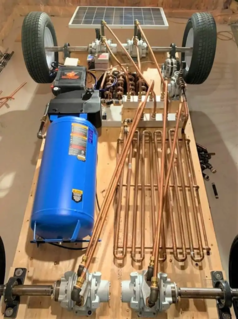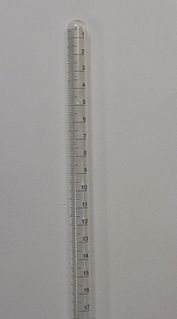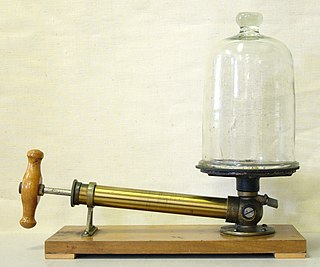
Argon is a chemical element with the symbol Ar and atomic number 18. It is in group 18 of the periodic table and is a noble gas. Argon is the third-most abundant gas in the Earth's atmosphere, at 0.934%. It is more than twice as abundant as water vapor, 23 times as abundant as carbon dioxide, and more than 500 times as abundant as neon. Argon is the most abundant noble gas in Earth's crust, comprising 0.00015% of the crust.

An engine or motor is a machine designed to convert one or more forms of energy into mechanical energy.

Pneumatic tubes are systems that propel cylindrical containers through networks of tubes by compressed air or by partial vacuum. They are used for transporting solid objects, as opposed to conventional pipelines, which transport fluids. Pneumatic tube networks gained acceptance in the late 19th and early 20th centuries for offices that needed to transport small, urgent packages over relatively short distances. Some installations grew to significant complexity, but were mostly superseded. In some settings, such as hospitals, they remain widespread and have been further extended and developed in the 21st century.
Instrumentation is a collective term for measuring instruments that are used for indicating, measuring and recording physical quantities. The term has its origins in the art and science of scientific instrument-making.

Coke is a grey, hard, and porous fuel with a high carbon content and few impurities, made by heating coal or oil in the absence of air—a destructive distillation process. It is an important industrial product, used mainly in iron ore smelting, but also as a fuel in stoves and forges when air pollution is a concern.

An air gun or airgun is a gun that fires projectiles pneumatically with compressed air or other gases that are mechanically pressurized without involving any chemical reactions, in contrast to a firearm, which pressurizes gases chemically via oxidation of combustible propellants that generates propulsive energy by breaking molecular bonds.

Pneumatics is a branch of engineering that makes use of gas or pressurized air.

A thermostat is a regulating device component which senses the temperature of a physical system and performs actions so that the system's temperature is maintained near a desired setpoint.

A grommet is a ring or edge strip inserted into a hole through thin material, typically a sheet of textile fabric, sheet metal or composite of carbon fiber, wood or honeycomb. Grommets are generally flared or collared on each side to keep them in place, and are often made of metal, plastic, or rubber. They may be used to prevent tearing or abrasion of the pierced material or protection from abrasion of the insulation on the wire, cable, line being routed through the penetration, and to cover sharp edges of the piercing, or all of the above.

Jean Baptiste André Dumas was a French chemist, best known for his works on organic analysis and synthesis, as well as the determination of atomic weights and molecular weights by measuring vapor densities. He also developed a method for the analysis of nitrogen in compounds.

A compressed-air vehicle (CAV) is a transport mechanism fueled by tanks of pressurized atmospheric gas and propelled by the release and expansion of the gas within a Pneumatic motor.
A pneumatic weapon is a weapon that fires a projectile by means of air pressure, similar in principle to the operation of pneumatic tube delivery systems. The term comes from a Greek word for "wind" or "breath" (πνεῦμα).
An air line is a tube, or hose, that contains and carries a compressed air supply. In industrial usage, this may be used to inflate car or bicycle tyres or power tools worked by compressed air, for breathing apparatus in hazardous environments and to operate many other pneumatic systems.

A eudiometer is a laboratory device that measures the change in volume of a gas mixture following a physical or chemical change.

A bell jar is a glass jar, similar in shape to a bell, and can be manufactured from a variety of materials. Bell jars are often used in laboratories to form and contain a vacuum. It is a common science apparatus used in experiments. Bell jars have a limited ability to create strong vacuums; vacuum chambers are available when higher performance is needed. They have been used to demonstrate the effect of vacuum on sound propagation.

In the history of science, pneumatic chemistry is an area of scientific research of the seventeenth, eighteenth, and early nineteenth centuries. Important goals of this work were the understanding of the physical properties of gases and how they relate to chemical reactions and, ultimately, the composition of matter. The rise of phlogiston theory, and its replacement by a new theory after the discovery of oxygen as a gaseous component of the Earth atmosphere and a chemical reagent participating in the combustion reactions, were addressed in the era of pneumatic chemistry.

A vertical form fill sealing machine is a type of automated assembly-line product packaging system, commonly used in the packaging industry for food, and a wide variety of other products. Walter Zwoyer, the inventor of the technology, patented his idea for the VFFS machine in 1936 while working with the Henry Heide Candy Company. The machine constructs plastic bags and stand-up pouches out of a flat roll of film, while simultaneously filling the bags with product and sealing the filled bags. Both solids and liquids can be bagged using this packaging system.

A pneumatic trough is a piece of laboratory apparatus used for collecting gases, such as hydrogen, oxygen and nitrogen. Pneumatic troughs require a liquid such as water. Scientists also have used mercury in pneumatic troughs, but usually only for the collection of water-soluble gases. Health and safety issues surrounding mercury generally prohibit its use in modern-day pneumatic troughs.

An oleo strut is a pneumatic air–oil hydraulic shock absorber used on the landing gear of most large aircraft and many smaller ones. This design cushions the impacts of landing and damps out vertical oscillations.
A diffusion tube is a scientific device that passively samples the concentration of one or more gases in the air, commonly used to monitor average air pollution levels over a period ranging from days to about a month. Diffusion tubes are widely used by local authorities for monitoring air quality in urban areas, in citizen science pollution-monitoring projects carried out by community groups and schools, and in indoor environments such as mines and museums.
















